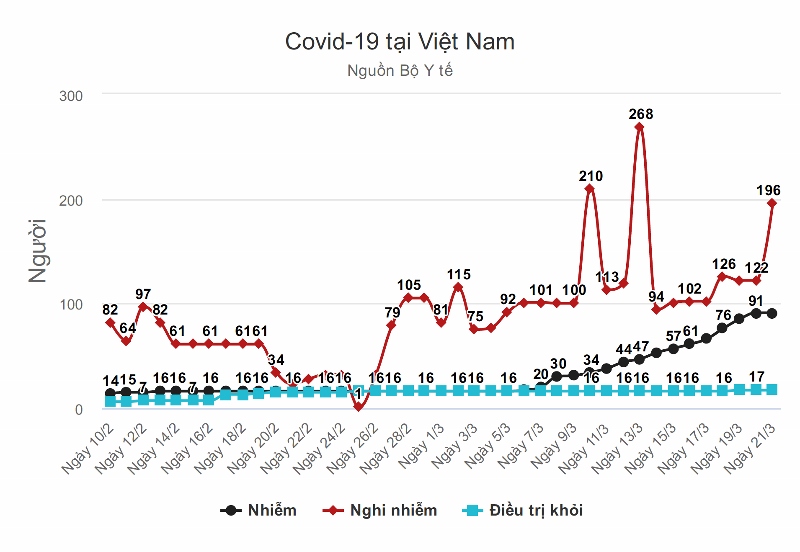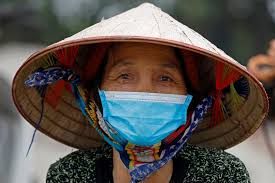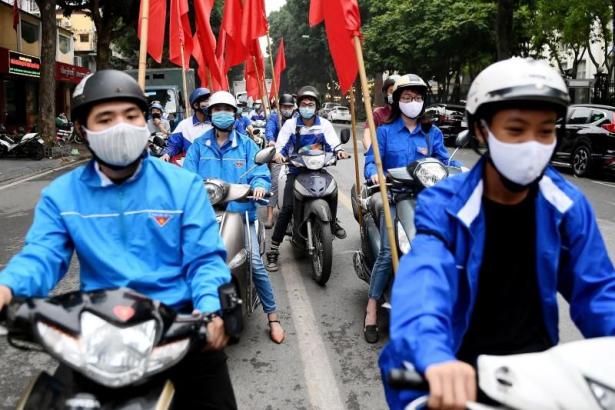What can we learn from Vietnam? Below are two perspectives: (1) An interview with public health leader Professor Le Vu Anh, and (2) Observations from Cathy Dang-Santa Ana, based on conversations with her mother who lives in Vietnam. And, (3) the video 'Jealousy Ms. Vy' (Corona Song), produced by the Vietnamese Institute of Occupational and Environmental Health, which as of Feb. 23, had already been viewed by 25 miilion viewers on YouTube.
(1) Interview with Professor Le Vu Anh, March 23, 2020
(2) Observations from Cathy Dang-Santa Ana, March 25, 2020
(3) Ghen Cô Vy| NIOEH x K.HUNG x MIN x ERIK | WASHING HAND SONG | CORONA SONG
(1) Interview with Professor Le Vu Anh, March 23, 2020
Vietnam has had only 141 cases of Covid-19 as of March 23, and so far, no deaths. Despite its proximity to China, and fewer resources than countries like Singapore, the country seems to have kept the virus under control.
Stephanie Luce interviewed Professor Le Vu Anh to see what we can learn from Vietnam.
Professor Le Vu Anh is a prominent public health leader and innovator in Vietnam. As the founding Dean of Hanoi School of Public Health (HSPH), he worked there for the latter half of his carrier before retiring. He is now President of the Vietnam Association of Public Health and editor of the Vietnam Journal of Public Health.
What is the overall philosophy and organizing principles of the Vietnamese health care model?
Like some other countries, Vietnam (VN) divides its health care system based on administrational levels . We have four levels: Central-Provincial-District and commune. Depending on population size of each level, health care infrastructure is equipped more or less for both human and material resources.
Under the commune level, we have village health workers (more on this below). With the increasing of a market approach, private sectors are now developed rather fast including both medicine and pharmacy (for both western and traditional medicine). For them to practice, they would need some sort of license and to get that they would have to pass some examination and a review of their infrastructure and of course, their course of implementing practices would be supervised periodically. Private sectors will be mobilized for providing some services in some emerging cases such as Covid19. And of course, one would be fined if they did anything wrong (both public and private sectors).
The slogan “prevention is better than curative” is always repeated but in reality, only a maximum 30% of investment goes to prevention. Hopefully, more and better evidence coming from the Covid19 epidemic would change this proportion a bit toward more prevention. For this, I would like to note that hospital and preventive sectors are working separately. The latter is working under provincial CDC (since CDC is only applied in provincial level). At central levels we still keep some leading prevention institutes under their old names. For example in Hanoi it is called The Hygiene and Epidemiology Institute, Pasteur Institutes in Ho Chi Minh City.
VN has developed a health insurance system (actually from beginning of the 1990s). It now covers 89% of the population, of which some certain percent be paid by government: for example, poor families, those who have made contributions for the country’s revolution, and some sort of old and disabled people/families.

Telangana Today (Hyderabad - India)
Can you tell me what were the major important steps that were taken in your epidemic response this year?
For this question, it may have two different approaches namely telling a story or using some concrete data. I use both. For that, we first of all need data.
One may ask about the reliability of this data. I would argue that (1) There are still all sorts of fake news and panic about the 2003 outbreak of Sars-Covy in VN. That outbreak killed a number of people including Dr. Carlo Urbani from WHO and doctors and nurses who provided services (especially at the V-P hospital). The lesson learnt was that panic and fake news would bring about unexpected consequences which are very difficult to control not only during that time but for a long time later. Transparent reporting and up-dating real information would be the best way of dealing with the outbreak in terms of communication.
And (2): We learned lessons from China when they kept saying nothing during the first two golden weeks of Covid-19 until Dr. Li Wenliang, an ophthalmologist in Wuhan decided to announce on his fan page about a new disease. This lesson reminded us not to go that way. And in VN, WHO has been invited to work closely with MoH from very beginning of any outbreak.
See the graph below. The black line is number of those who have Covid (+); Red line: people those who shared space with Covid (+) and seen as suspected; Blue line: people who have been healed and their test turned to Covid (-).

For the Black Line: All were asked to hospitalize. Those who have symptoms will be treated until healed and they test Covid (-). These people may need longer than 14 days. No dead have been recorded so far among this group. You may see the case 16 started hospitalization from February14 and lasted until March 5. Between that period, one case has been identified.
For the Red Line: Not all, but those who have symptom(s), and those who had close contact with a positive case (black) will be tested. These people will be called F1. Whenever any F1 turned into a case, F1 will automatically be named F2 and be called for quarantine. Before that they have been remind that they are at risk but can be quarantined at home with very careful instructions of how to best do home quarantine. This is a bit trade-off between two difficult choices: applying quarantine to all suspected people and financial limitation!
For the Blue Line: Since no dead has been recorded, the blue line reflects (1) Those who have been healed with Covid19 (-). and (2) The number of days under treatment in the hospital. For example, patient number 16 has 35 days in the hospital! Note that all central quarantine and treatment in hospital will be free of charge. This says something about the cost for the Covid epidemic and is the reason for government to call for support nationally and internationally. This also has been a focus of all mass media and communication about the government for helping its citizen in such critical time especially in comparison to other countries where people have to pay a lot for both testing and treatment.
It has been shown recently that the payment strategy for Covid19 has changed in some countries like Canada and the UK toward free for all! But VN did this immediately, from the very beginning and for foreigners also.
Mass media and communication also strongly addressed what they called “fake news” and panic control. Unlike China, Vietnam is still allowing FaceBook, Twister, Zalo etc. together with official communication. This is very effective in addressing communication problems. For example, one man used chloroquine phosphate for prevention of Covid19 following news in FaceBook and had to go to the ICU due to intoxication. Immediately the afternoon TV news covered that case with some comments from the Vice-Minister of Health, giving warning about using news, especially during Covid time! Or a clip about a Polish-Vietnamese person who arrived at the Airport and was asked to go into quarantine. She complained and shared her dissatisfaction, but her case was spread widely and she was criticized by the internet community and she ended up openly sorry for that behaviors.
How is the epidemic response coordinated, what are the roles of non-medical specialists? Do you have a role for community health care workers?
From the very beginning VN has created a so called National Steering Committee (NSC) for Covid19 chaired by a Vice-Prime Minister. The Vice-Standing Chair is the Vice-Minister of Health and other members are all related Ministries. Steering committees have also been established in each province as well as in each Ministry in order to make sure that all instructions and activities proposed by the NSC are carried out. This reflects clearly a multi-disciplinary approach that should be used in integrated planning during an emergency situation. The Prime Minister appeared daily on the TV news addressing all issues and problems. This emphasizes the roles of different partners involved and encouraged them to do good works.
It seems Vietnam has done so much for public health under a much smaller budget than many countries. How do you maximize your resources?
I suppose that some explanation above has explained partly what VN is doing. We have to consider the financial limitation and the best way to solve it in reality. Having more money, VN may do it a bit differently! I do not know in detail how much has been paid for whatever strategy since we don’t have such kind of data.
Can you tell me about community health care practices?
VN has a commune health station in each commune with around 3-5-7 paid positions depending on the population size of the commune. They are pediatric-obstetric staff(s), traditional staff and preventive staff in charge of vaccination etc. They are all being trained in medicine and pharmacy, and/or public health depending on individual people’s choice since the kind of training degree will decide one’s salary and promotion. At the lower level, VN has some positions for village health worker, working on population issues or nutrition etc. They will be paid also but only with some small amount of money. At higher levels: district, provincial, central levels, the professional training functions a bit different.
What lessons from Vietnam health care are important to share?
1. Quarantine can be seen as a rather cheap and effective approach where you have enough facilities like the Army with their camps, and human resources.
2. Testing is important but a bit costly and that makes you have to think carefully before deciding who to test.
3. Free of charge for all services is a good way when you have enough choices and supporters and the number of those who use the services are still under control.

(2) Observations from Cathy Dang-Santa Ana, March 25, 2020
Cathy Dang-Santa Ana is an activist who lives in New York City. She shares these comments based on conversations with her mother.
Every time I get off the phone with my mom in Vietnam, my mind is blown away about all that the government is doing for our people there.
1) Some people may feel this is authoritarian, but I think aspects of it are justified. Anyone who travels into the country has to get their temperature checked and if they appear sick, they take you in for 14-day quarantine (paid by the government). If you seem fine, they will still take you in but just for a few days to see how you’re doing and will let you go home. But they ask that you stay in the house for 2 weeks. They then publish person’s name and what they look like to the district newspaper to let their neighbors know someone recently traveled abroad in that house and if they leave, to call the government.
2) If you live in a large building and if one person is sick in your building, the whole building isn’t allowed to leave. But the government will cook you fresh meals and deliver it to your doorstep, 3 meals a day for less than $2-$6. For. Each. Person. In. The. Household. For two weeks until everyone is clear.
3) They are setting up sanitizing systems not just hand sanitizers to sanitize a person’s entire body, at the entrance and exit of every large building.
4) If you are sick and don’t feel comfortable living in your current home around others and don’t want to get them sick, they’ve set up a discounted cheap rate for you to rent a hotel room since the tourism industry is down. They’re doing it to quarantine people who are carrying but not really ill and to support the industry and workers. And if you choose to stay at a hotel, the government will send a doctor (a doctor, not a PA or nurse. a doctor) to your hotel to check on you at NO COST (all paid by the government).
5) Because it’s a country that already heavily uses masks, everyone has one for when they drive on their mopeds. But when you go out now, everyone is asked to wear one.
6) There is no price gouging at all nor hoarding. Soap and hand sanitizers are affordable and available to everyone.
7) If the government finds out you’ve been traveling out of the country, they come to your house to check if you’re sick and if you are, they take you into quarantine.
And according to Daniel Hoài Tiến Nguyễn, "the Prime Minister stopped all exports of rice to ensure food security for the country. From the beginning, the Prime Minister said 'no one will be left behind.' The government has made it their mission to ensure Vietnamese who want to come home will be brought home. A huge part of the effort is they also mobilized neighborhood self defense militias and neighborhood organizations to help spread the information and keep people posted about new government directives (yesterday all gyms, for example, now must close until April 4th and all morning people are door knocking to let everyone know). This is organizing and preparedness. Imagine Hurricane Katrina with this kind of response!"
This is all with just less than 150 cases in the country. And there’s probably some kind of rent moratorium she doesn’t even know about yet.
(3) Ghen Cô Vy| NIOEH x K.HUNG x MIN x ERIK | WASHING HAND SONG | CORONA SONG
Watch here.
This was viewed by 25 million on YouTube, as of Feb. 23.
Here is a rough Google translation
'Jealousy Ms. Vy' is a creative project of the Institute of Occupational and Environmental Health, in collaboration with musician Khac Hung, singer Min and singer Erik.
Through this project, we look forward to empowering and trusting the community, so that we can join hands to combat COVID-19 (aka nCoV-2019).
In this critical moment of fighting the plague, we hope the song can spread more fire and less stress to the frontline soldiers of this war. That is the team of experts, physicians, health workers and millions of workers who are in the front lines of exposure and daily struggle with the disease.
Let our community take the initiative in implementing preventive habits as recommended by specialized agencies and spreading good and kind things to win the disease together.
Vietnam is determined to win the epidemic!
Follow updates on the disease on the Ministry of Health website.
Or on the Institute's website:
Credits:
Producer: Institute of Occupational and Environmental Health
Author: Khac Hung
Music production: Khac Hung
Singer: Min x Erik
- Subscribe to the Youtube channel "NIOEH-Institute of Occupational Health and Environment"
- Follow the Facebook page of the "Institute of Occupational Health and Environment"
- Website "Institute of Occupational Health and Environment"
[Stephanie Luce is a professor at the CUNY School of Labor and Urban Studies and a member of the Professional Staff Congress/CUNY-AFT. She is a member of the Portside collective.]


Spread the word